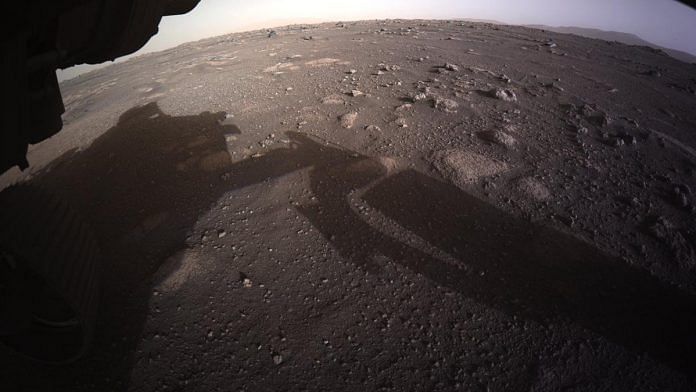Bengaluru: US space agency NASA released a first of its kind video of the Perseverance rover landing on the surface of the planet Mars. This is the first time the landing of a rover on another planet was captured on video.
The Perseverance rover touched down on the planet on 18 February with the help of a powered sky crane and both the rover and the crane were fitted with cameras that captured the rover’s descent on to the sandy surface.
The rover is also equipped with two microphones. While the microphone that was supposed to capture sounds of the landing did not collect “usable data” during the process, it recorded and sent audio back after a successful landing.
The agency also released the mission’s first panorama of the rover’s landing location, taken by the two Navigation Cameras located on its body.
The media were released in a press conference held just after midnight (Tuesday morning IST).
Also read: Mars, Moon & a fresh pair of eyes in the sky — the big space missions planned for 2021
What the video shows
The video starts 11 km above the surface of the planet, about 230 seconds after the spacecraft entered the Martian atmosphere at over 20,000 kph.
The beginning of the video is black because the camera lens is covered but in a second, the parachute to slow down the spacecraft is deployed, going from a compressed 46cm x 66cm cylinder to its full 21.5 metre canopy.
The video then shows the heat shield being separated after the descending rover has slowed down.
While the sky crane’s camera captured the video of Perseverance dangling from it and descending on to the surface, the rover looked up to capture the sky crane that was ferrying it to the surface.
A close up of the Martian surface can also be seen, from a camera looking down from the dangling rover, with dust and the Martian regolith (soil) being blown in interesting patterns from the wind during the descent. This occurred 80 seconds and 2,130 metres later, when the rocket engines from the crane kicked up dust and rocks that haven’t been touched for billions of years.
The rover’s wheels then make contact with the surface in a cloud of dust, at 2.6 kph, and blades sever the cables from the crane that lowered the rover. In the last frame, the sky crane can be seen detaching, climbing, and moving away, to safely fall away from the rover.
“Now we finally have a front-row view to what we call ‘the seven minutes of terror’ while landing on Mars,” said Michael Watkins, director of NASA’s Jet Propulsion Laboratory that manages the mission, in an accompanying statement.
He added: “From the explosive opening of the parachute to the landing rockets’ plume sending dust and debris flying at touchdown, it’s absolutely awe-inspiring.”
The cameras were as much scientific as they were for public outreach, according to the scientists at NASA.
“We put the EDL camera system onto the spacecraft not only for the opportunity to gain a better understanding of our spacecraft’s performance during entry, descent, and landing, but also because we wanted to take the public along for the ride of a lifetime — landing on the surface of Mars,” said Dave Gruel, lead engineer for Mars 2020 Perseverance’s EDL camera and microphone subsystem.
“We know the public is fascinated with Mars exploration, so we added the EDL Cam microphone to the vehicle because we hoped it could enhance the experience, especially for visually-impaired space fans, and engage and inspire people around the world,” said Gruel in the statement.
The images and videos were all captured by a total of five cameras located all over the rover and the sky crane.
The audio captured by the rover recorded sounds from the surface of the planet, including both soft imperceptible wind as well as mechanical sounds from the rover itself.
Now that you’ve seen Mars, hear it. Grab some headphones and listen to the first sounds captured by one of my microphones. ?https://t.co/JswvAWC2IP#CountdownToMars
— NASA's Perseverance Mars Rover (@NASAPersevere) February 22, 2021
Also read: India’s next Mars mission likely to be an orbiter, ISRO to also explore Venus
What’s next
NASA has also released around 3,000 unprocessed raw images, which processing enthusiasts as well as the official team will work on over the coming days.
Scan this image for the various pieces of my landing system, which did their jobs perfectly before coming to rest on Mars. Teams of experts poured years of work into each one. My safe landing is what tells you they nailed it.https://t.co/g1QIh0xIqZ
?: @HiRISE#CountdownToMars pic.twitter.com/2QoFWhKXQr
— NASA's Perseverance Mars Rover (@NASAPersevere) February 22, 2021
The agency is currently running a check on other systems and payloads, and more images, audio, and other kinds of data are expected to stream in on a daily basis.
The rover landed in the Jezero crater, an ancient lakebed that once held liquid water on Mars some 3.5 billion years ago. It will perform its astrobiological mission of hunting for signs of past life and studying habitability in this region, a prime candidates for ancient fossils of microbial life.
The mission also contains the Ingenuity helicopter, which will be the first to fly on any planet. It is expected to perform its first test flight in a month, after the rover drives down to the test flight site and releases the helicopter, before driving away to a safe distance.
Also read: 1,000 yrs for a trip around Sun — scientists map orbit of most distant object in solar system




Its really science fiction come to life.